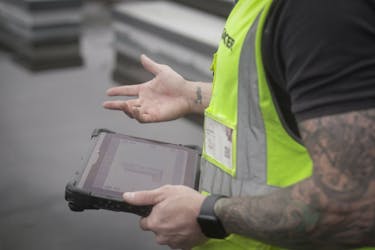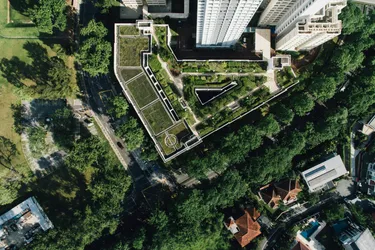
Solar PV Flex is a unique and lightweight combination of CIGS solar panels and bitumen waterproofing
Roof-based solar power generation is an exciting and fast-changing area of technology. The potential for contributing locally and directly to sustainability is growing quickly every year, as is the potential for energy self-sufficiency and greatly reduced bills.
Traditionally, though, many roofs have been seen as unsuitable for these projects, but emerging technology is unleashing the potential of solar power even in challenging cases. Whether you are renovating a roof with limited load capacity, working to preserve the existing aesthetics of the space, or dealing with a far from flat roof, Solar PV Flex can add solar power to virtually any structure.
What is Solar PV Flex?
Solar PV Flex is a lightweight, thin-film alternative to crystalline photovoltaic (PV) arrays. The modules use CIGS solar cells, and are designed to bond directly to our Excel® Solar bitumen waterproofing membrane. The modules, which are just 2.5mm thick, offer a simple non-penetrative solution. The system is available as a single or multi-layer warm roof or overlay.
The Solar PV Flex is one of our three solar options. The other two systems include our biosolar living roof, and high-efficiency traditional crystalline PV panels. We discuss the Axter Solar range here and Biosolar PV system in more detail here.
When is Solar PV Flex the right choice?
A traditional solution using ballasted crystalline panels is the most cost-effective way to generate a given wattage, so Solar PV is what we would recommend in the general case. But there are a number of situations in which the unique advantages of Solar PV Flex mean it is the right choice for the job:
- The system is very light, making it ideal for cases where the roof cannot support heavier alternatives
- The panels can be attached to a roof of any shape, even curved structures
- In some locations, traditional panels are too big and visible to achieve planning permission or our client’s own aesthetic vision
A lightweight option for renewable energy
Solar PV Flex weighs just 2.9 kg per square metre. The figure for a ballasted PV roof might be 80 or 100 kg, and 25 or 30 kg for traditional panels attached with our Universal Fixing Points. This makes the flexible system ideal for many retrofit projects, as well as extensions.
One client we are working with is a data centre. High energy use is a given here, so it’s a case of energy from their roof or bills through the roof. The existing structure has little capacity for bearing additional loads, so traditional panels, however fixed, were not an option. Solar Flex offered the ideal solution to achieve energy generation with minimal additional weight, with the roof being suitable to be overlaid on the existing structure.
An ideal choice for non-flat roofs
We have yet to encounter a roof which was incompatible with Solar PV Flex. The system can be attached to flat or pitched roofs, as well as roofs of irregular or curved construction. One partner approached us seeking a design proposal for an observatory of the traditional domed shape, while another project at design stage is for a large barrel shaped roof on a historic building.
Meeting the needs of your local authority – or your own visual requirements
One client we are working with manages a grade 1 listed building. Authorities had made it clear that any installation visible from the adjacent road would not be approved. The Solar Flex discreet film system presented a way to achieve sustainability goals while also meeting planning permission requirements.
More everyday structures can also face regulatory hurdles. A project we completed recently involves a standard family home, but in a busy part of London, where permission would not be granted for any solar roof that overshadowed neighbouring buildings.
On another project in Norfolk the client didn’t want to obstruct the lovely view of the nearby Norfolk coastline with large panels, in this case there was no planning difficulties, but instead Solar Flex offered a perfect aesthetic design solution with minimal visual impact.
Other advantages of Solar PV Flex
The system offers a B Roof (T4) fire safety rating, which is quite unique for a product of this type.
The modules can generate electricity with an efficiency of 16.4%. This is high for a flexible system, though certainly lower than crystalline PV. Having said that, it’s important to note that the efficiency value captures only the peak performance of the system and not the overall output.
Luke Rootham, the Product Manager for Axter Solar explains the difference: “A traditional panel might have 6 or 8 diodes, but we use almost 80. What that means in practical terms is they offer exceptional shade tolerance – the panels will perform well even in poorer weather, and they will start working earlier in the morning and go on for longer in the evening. When we compared data on the output of Sheffield University’s own crystalline solar array with a comparable project of ours using Solar Flex, the two systems had almost the same output over our test day, because the Solar Flex was generating over a longer period of the day.”
As well as increasing the total energy output, this characteristic of Solar PV Flex makes it ideal for situations where no battery is installed, but the building is in use outside standard office hours – your roof will be your energy source for more of each day.
Sometimes more than one system is needed to complete a project
One ongoing installation we are working on near Cambridge involves a number of buildings, including several of the New Meaning Foundation charity’s Space Micro-Homes, designed as pods to house the homeless. While the pods can accommodate traditional Axter Solar PV panels, as can a café extension on the site, the nearby church building which is also part of the project required an alternative solution. Axter’s Solar Flex system was chosen as the thin-film offers a more invisible finish sympathetic to the historic structure.
We first worked with New Meaning Foundation on another solar project for our climate and community charity partner, Emmaus Suffolk, where we donated 9 of our Solar PV panels, design and specification to make its two modular housing units for vulnerable people in Ipswich energy bill-free. Learn more about that project here.
Our ethos is to offer the right system for the right application, and with our breadth of solutions, the Axter Solar range is designed to help achieve your sustainability goals and overcome many of the common challenges projects face.
To learn more about which Solar system is right for your next project, please get in touch.


